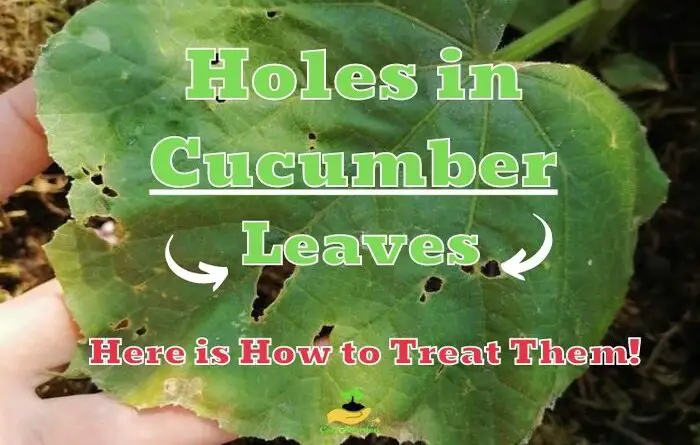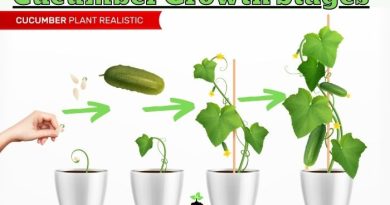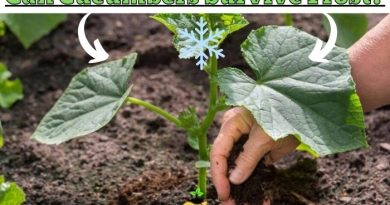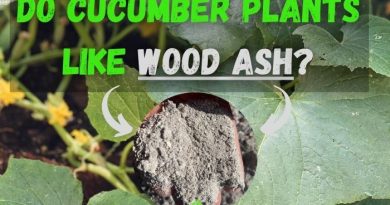Holes in Cucumber Leaves: Here’s How to Treat Them!
Are you noticing small holes in your cucumber leaves? You’re not alone. In this article, we’ll dive into the different causes of holes in cucumber leaves and provide you with actionable tips to prevent them.
So, grab a cup of tea, get comfortable, and let’s get started!
Holes in cucumber leaves can be caused by a variety of factors, including insect pests like striped and spotted cucumber beetles and slugs, as well as fungal diseases like anthracnose and downy mildew. To prevent holes in cucumber leaves, it’s important to practice good garden hygiene, including removing any infected leaves and keeping the garden free of debris.
Top 6 Most Common Causes of Holes in Cucumber Leaves
Cucumber plants are commonly grown in home gardens and commercial farms. One of the problems that cucumber plants can face is the development of holes in their leaves, which can be caused by various factors.
| Causes of Holes in Cucumber Leaves | Cucumber Symptoms | Prevention/Treatment |
| 1. Striped and Spotted Cucumber Beetle | Small, round holes in leaves | Use floating row covers, handpick beetles. |
| 2. Slugs | Holes in leaves caused by feeding | Use physical barriers, handpick slugs, use slug bait or repellent. |
| 3. Anthracnose | Dark, sunken spots with holes | Rotate crops, use fungicides. |
| 4. Angular Leaf Spot Disease | Irregular holes with brown spots on leaves | Use fungicides, water at the base of plants. |
| 5. Scab | Rough, scabby spots on fruit | Use resistant varieties, remove infected fruit. |
| 6. Root Rot and Powdery Mildew | Wilting, yellowing leaves | Improve soil drainage, use fungicides. |
Here are the top 6 most common causes of holes in cucumber leaves:
1. Striped and Spotted Cucumber Beetle
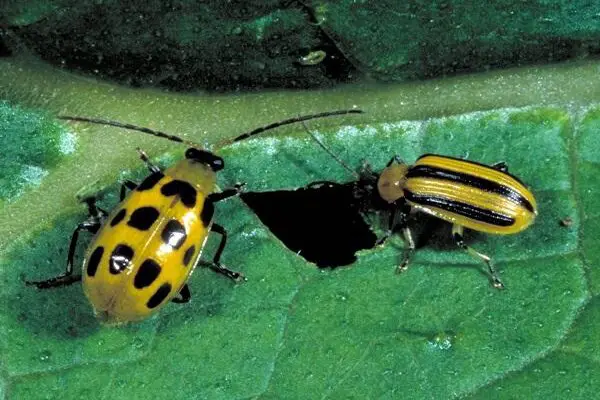
The striped and spotted cucumber beetle is a common pest that can cause significant damage to cucumber plants. These beetles are small, about ¼ inch long, and have black and yellow stripes or spots on their bodies. The adult beetles mainly feed on the cucumber leaves, leaving irregularly shaped holes that can eventually lead to defoliation and reduced plant vigor.
They also feed on the stems, and flowers of the cucumber plant and can also spread bacterial wilt disease, which can be fatal to the entire cucurbit plant.
One reason why cucumber beetles are particularly damaging is that they can quickly reproduce, leading to a large infestation in a short amount of time. The adult beetles can lay hundreds of eggs throughout the growing season, and the larvae can cause damage to the roots of the plant.
To prevent cucumber beetle infestations, it’s important to keep the garden clean and free of debris, as this can be a breeding ground for the beetles.
It’s also important to rotate crops each year to avoid creating a favorable environment for the beetles. Planting companion plants such as radishes and marigolds can also help to repel cucumber beetles.
If you do notice an infestation, there are several treatments you can use to control it.
Treatment
To control cucumber beetle infestations, here are a few solutions:
- Hand-pick the beetles: If you only have a few beetles, you can simply pick them off the plants and dispose of them. It’s important to do this in the morning when the beetles are less active.
- Use row covers: Covering the plants with lightweight fabric can prevent beetles from reaching the plants and laying eggs. Make sure the edges of the fabric are buried in the soil to prevent beetles from crawling underneath.
- Apply insecticidal soap: Insecticidal soaps can be used to control cucumber beetles. These soaps are made from natural ingredients and are safe for use around humans and pets. Follow the manufacturer’s instructions for application.
- Apply neem oil: Neem oil is a natural insecticide that can be sprayed on plants to control cucumber beetles. It works by disrupting the insect’s reproductive cycle and causing it to stop feeding. Apply it in the evening when the bees are less active, and avoid spraying on hot, sunny days.
Table with some cucumber varieties that are resistant to cucumber beetles
| Variety | Type | Resistance |
|---|---|---|
| ‘Marketmore 76’ | Slicing | Striped and spotted cucumber beetles |
| ‘Dasher II’ | Slicing | Striped and spotted cucumber beetles |
| ‘Saladin’ | Middle Eastern | Striped and spotted cucumber beetles |
| ‘Fanfare’ | Pickling | Striped and spotted cucumber beetles |
| ‘Liberty’ | Pickling | Striped cucumber beetles |
https://portal.ct.gov/-/media/CAES/DOCUMENTS/Publications/Fact_Sheets/Entomology/Cucumber_Beetles_Acalymma.pdf
2. Slugs
Slugs cause holes in cucumber leaves by using their rasping mouthparts to feed on the plant’s tissue. The mouthparts of slugs are like tiny, sharp teeth that scrape and tear the leaves, creating holes in the process.
Slugs are known pests belonging to the type of mollusk. They are activated in humid and warm conditions, and are also found in almost all other regions.
Mollusks crawl out mainly at night, and in the morning they go into the surface layer of soil to a depth of 10 cm. They feed on the leaves and lashes of cucumbers, starting to eat the plant from young shoots.
The slug’s body is bristly, striped, the shape is narrow. They actively feed on leaf tissue juices. As a result, the lashes begin to bend, and spots appear on the plates, which gradually increase. Over time, through holes appear on the cucumber leaves.
Usually, cucumber leaves look like this in remote areas, where the gardener is infrequent and does not have time to notice these slippery pests and remove them from the site.
Slugs love warmth and moisture, but not heat, so in places where it is warm and humid, as a rule, there are a lot of them. In rainy years, under every leaf, under every branch, and even garden tools lying on the ground, you can see dozens of these voracious pests.
Even if, walking around the garden, you did not notice a single slug or its slimy trace on the leaves, you should not be sure that they are not on your site.
Slugs harm not only cucumber leaves, their diet includes young shoots of cabbage, tomato leaves, strawberries and even potato.
The damage begins with the fact that a round and through hole suddenly appears on the leaf, but if you don’t notice the “work” of the slug in time, then only the petiole and veins will remain on the leaf.
The main thing is that before you decide to protect your garden in this way, make sure that there are no pests already in it. Otherwise, even if by some miracle they want to move from your site to the neighboring one, they will not succeed and, willy-nilly, they will have to eat up your cucumbers.
Treatment
Let’s start with prevention – even if you have little space and want to land everything and more, you should not thicken the soil.
You should leave the optimal distance between plants, well ventilated and lit. Slugs will not be able to move on dry land warmed by the sun.
Never overwater cucumbers plants. There should be as much moisture as needed, watering “in reserve” can only lead to moisture stagnation – such places are simply a paradise for slugs.
Do not banish from your garden toads, lizards, garden frogs, and hedgehogs because, for them, slugs are delicious prey. These peaceful and harmless animals can save your garden from a whole horde of slippery pests in a couple of days.
Well, if you set up a garden where nothing lives except dragonflies, butterflies and grasshoppers, you will have to dig a small groove along the boundaries of the site, as if protecting the fortress from the enemy, which will be covered with lime or tobacco dust.
Well, the most effective way is to till the soil with slaked lime, wood ash or superphosphate ground into dust. Cucumbers can be sprayed late in the evening with a solution of potassium salt (about 700 grams per bucket of water), spending half a liter per square meter.
If this method suddenly does not help, then you can treat the beds with quicklime a second time at a dose of approximately 20 g per square meter. I heard that a mixture of lime and tobacco dust helps, a kind of double whammy.
3. Anthracnose
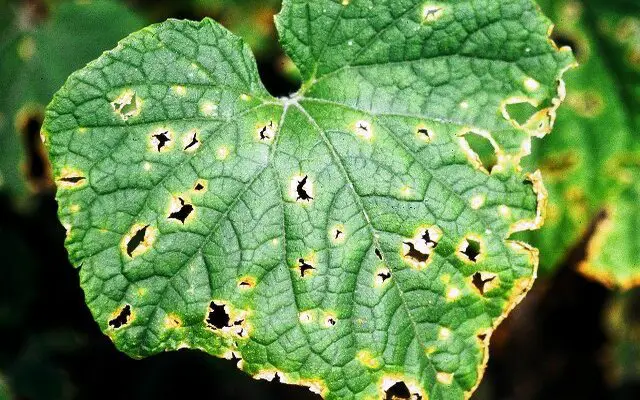
Anthracnose in cucumbers causes holes in leaves by infecting and weakening the plant tissue. The disease appears as dark, sunken lesions on the leaves, stems, and fruits of the plant. These lesions can cause the leaves to curl and die off and can reduce the yield of your cucumber.
Anthracnose can be particularly damaging during periods of high humidity and moisture, as this creates an ideal environment for the fungus to grow and spread. The disease can be spread by contaminated soil, tools, or plant debris.
To prevent anthracnose from affecting your cucumber plants, it’s important to maintain good hygiene practices in the garden. This includes removing and disposing of any infected plant material and avoiding overhead watering. It’s also important to rotate crops each year to prevent the buildup of the fungus in the soil.
Treatment
If you do notice anthracnose on your cucumber plants, there are several treatments you can use to control it:
- Remove infected plant material: It’s important to remove any infected leaves, stems, or fruits from the plant as soon as possible. This can help to prevent the spread of the disease.
- Apply fungicide: Fungicides can be used to control anthracnose. Choose a fungicide that is labeled for use on cucumbers and follow the manufacturer’s instructions for application.
- Practice good watering habits: Avoid overhead watering and try to water the plants at the base. This can help to prevent the spread of the fungus.
- Improve air circulation: Good air circulation can help to prevent the buildup of moisture and humidity, which can contribute to the spread of the fungus. Prune any crowded or overlapping branches to improve air circulation around the plants.
Table listing some cucumber varieties that are resistant to anthracnose
| Variety | Type | Resistance |
|---|---|---|
| ‘Bush Whopper’ | Pickling | Anthracnose |
| ‘Dasher II’ | Slicing | Anthracnose |
| ‘Marketmore 76’ | Slicing | Anthracnose |
| ‘Straight Eight’ | Slicing | Anthracnose |
| ‘Salad Bush’ | Bush | Anthracnose |
| ‘Sweet Success’ | Slicing | Anthracnose |
4. Angular Leaf Spot Disease
Angular Leaf Spot Disease is a bacterial disease caused by the bacterium Pseudomonas syringae pv. lachrymans that can cause holes in cucumber leaves. The disease typically starts as small, water-soaked lesions on the leaves that gradually enlarge and become angular in shape, often restricted by small veins. The lesions may also have yellow chlorotic halos.
The disease can be quite devastating to cucumber plants, as it causes angular, water-soaked lesions on the leaves that eventually turn brown and form holes in the leaves. Severe infections can cause defoliation and reduced yields, which can be frustrating for any gardener.
Angular leaf spot is typically spread through contaminated seeds, soil, or water. The bacteria can thrive in warm and humid conditions, which can cause the disease to spread quickly. That’s why it’s important to take steps to prevent the disease from taking hold in the first place.
To prevent angular leaf spot, you can practice good hygiene practices in the garden. Use disease-free seeds, avoid overhead watering, and rotate your crops each year to prevent the buildup of bacteria in the soil. It’s also important to remove any infected plant material as soon as you notice it to prevent the spread of the disease.
By taking these preventative measures, you can help ensure that your cucumber plants stay healthy and disease-free. If you do notice an angular leaf spot on your plants, there are several treatments you can use to control it which we’ll explore in the next section.
Treatment
If you do notice angular leaf spots on your cucumber plants, there are several treatments you can use to control them:
- Remove infected plant material: As mentioned earlier, it’s important to remove any infected leaves from the plant as soon as possible. This can help to prevent the spread of the disease.
- Apply copper-based fungicide: Copper-based fungicides can be used to control angular leaf spots. Choose a fungicide that is labeled for use on cucumbers and follow the manufacturer’s instructions for application.
- Practice good watering habits: Avoid overhead watering and try to water the plants at the base. This can help to prevent the spread of the bacteria.
- Improve air circulation: Good air circulation can help to prevent the buildup of moisture and humidity, which can contribute to the spread of bacteria. Prune any crowded or overlapping branches to improve air circulation around the plants.
Table with some cucumber varieties that have been reported to be resistant to Angular Leaf Spot Disease
| Variety | Description |
|---|---|
| ‘Dasher II’ | An early-maturing slicing cucumber that is resistant to ALS and other diseases. |
| ‘Thunder’ | A pickling cucumber that is resistant to ALS and other diseases. |
| ‘Vlaspik’ | A pickling cucumber that is resistant to ALS and other diseases. |
| ‘Calypso’ | A slicing cucumber that is resistant to ALS and other diseases. |
| ‘Marketmore 76’ | A slicing cucumber that is resistant to ALS and other diseases. |
| ‘Saladin’ | A slicing cucumber that is resistant to ALS and other diseases. |
5. Cucumber Scab
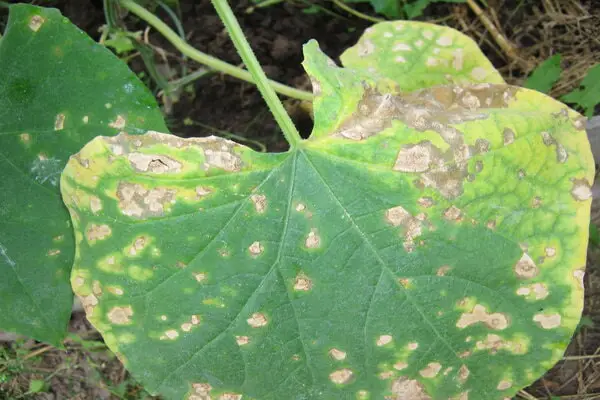
Cucumber Scab is a fungal disease caused by the fungus Cladosporium cucumerinum resulting in the formation of holes, in cucumber leaves.
Initially, it appears as water-soaked lesions on the leaves that gradually increase in size and change color to brown or black. Sometimes these lesions may also have scabby areas that resemble warts.
As the disease advances the affected areas, on the leaves may become necrotic and create holes leading to weakened plants and reduced yields.
The disease can spread quickly under warm and humid conditions, leading to yellowing and eventual death of the leaves. The fungus can also cause the fruit to become discolored, rough, and bumpy, rendering them unsuitable for consumption.
You can prevent scabs by taking preventive measures such as providing adequate water, nutrients, and sunlight, and practicing good hygiene practices in the garden.
It is essential to remove any infected plant material and avoid overhead watering. It’s best to maintain good air circulation by pruning crowded or overlapping branches and removing weeds.
If scab is observed on your cucumber plants, it’s essential to take prompt action to control its spread. Fungicides that are specifically labeled for cucumbers can be applied to control the fungus. Infected leaves and debris should be removed and disposed of carefully to prevent further spread.
It’s best to avoid watering the leaves and instead, water at the base of the plant. Maintaining good hygiene and providing ideal growing conditions can help prevent scabs and keep your cucumber plants healthy.
Treatment
If you do notice scabs on your cucumber plants, there are several treatments you can use to control it:
- Apply fungicide: Fungicides can be used to control scabs. Choose a fungicide that is labeled for use on cucumbers and follow the manufacturer’s instructions for application.
- Remove infected plant material: As with other diseases, it’s important to remove any infected leaves from the plant as soon as possible. This can help to prevent the spread of the disease.
- Practice good watering habits: Avoid overhead watering and try to water the plants at the base. This can help to prevent the spread of the fungus.
- Improve air circulation: Good air circulation can help to prevent the buildup of moisture and humidity, which can contribute to the spread of the fungus. Prune any crowded or overlapping branches to improve air circulation around the plants.
Table with cucumber varieties that have been reported to be resistant to Scab
| Variety | Description |
|---|---|
| ‘Alcazar F1’ | Cucumber that has shown moderate tolerance to Scab. |
| ‘Bristol F1’ | Cucumber that has shown moderate tolerance to Scab. |
| ‘Bush Crop’ | Moderate tolerance to Scab. |
| ‘Centella F1’ | Moderate tolerance to Scab. |
| ‘Darlington F1’ | Moderate tolerance to Scab. |
| ‘Goliath’ | Moderate tolerance to Scab. |
6. Root Rot and Powdery Mildew
Root rot and powdery mildew are two common diseases that can cause holes in cucumber leaves, leading to stunted growth and reduced yields.
Root rot is a fungal disease that attacks the roots of the cucumber plant, causing them to rot and decay. As a result, the cucurbit plant is unable to absorb nutrients and water, leading to yellowing and wilting of the leaves. This weakens the plant and makes it more susceptible to other diseases and pests, including powdery mildew.
Powdery mildew, on the other hand, is a fungal disease that appears as a white powdery coating on the leaves and stems of cucumber plants. It can also cause small holes in the leaves as it weakens the plant and makes it more vulnerable to other pests and diseases.
Both root rot and powdery mildew thrive in warm and humid conditions, making them a common problem in greenhouses and other enclosed environments.
To prevent these diseases, it is important to maintain good hygiene and ensure proper ventilation and air circulation. Proper watering and fertilization can also help to strengthen the plant’s resistance to these diseases.
Treatment
- To control root rot and powdery mildew, it is essential to take prompt action to prevent their spread. Fungicides labeled for the specific diseases affecting your plants can be used as a treatment option. Additionally, removing and disposing of infected plant material, improving soil drainage, and avoiding overcrowding can help reduce the spread of the disease.
- For powdery mildew, spraying plants with a baking soda solution (1 tablespoon of baking soda in a gallon of water) can help control the disease. For root rot, it is essential to improve soil drainage by adding organic matter such as compost or peat moss to the soil. If the roots are severely affected, it may be necessary to remove and dispose of the infected plants. Regularly monitoring the plants for signs of disease and taking prompt action can help prevent the spread of root rot and powdery mildew.
How To Prevent Holes in Cucumber Leaves: A Step-by-Step Guide
If you’re growing cucumbers, it’s important to keep the leaves healthy and free from damage. Here’s a step-by-step guide to help prevent holes in cucumber leaves.
Step 1: Choose a Suitable Location
Cucumbers prefer a location that is warm and sunny, with well-draining soil. Make sure to choose a site that gets at least 6 hours of sunlight per day. It’s also important to avoid areas where cucumbers have been grown in the past few years, as this can increase the risk of disease.
Step 2: Use Good Planting Practices
When planting cucumbers, it’s important to space them properly to allow for good air circulation. Cucumbers can be planted in hills or rows, depending on your preference.
If planting in rows, space the plants 12 to 18 inches apart, and if planting in hills, space them 36 to 60 inches apart. Be sure to also plant them at the right depth – about 1 inch deep.
Step 3: Water Consistently
Cucumbers need consistent moisture to thrive, so it’s important to water them regularly. Avoid getting water on the leaves, as this can lead to fungal diseases. Instead, use a soaker hose or drip irrigation system to water the plants at their base.
Step 4: Fertilize Appropriately
Cucumbers need plenty of nutrients to grow well, so it’s important to fertilize them appropriately. Use a balanced fertilizer, such as a 10-10-10, and apply it according to the manufacturer’s instructions. Over-fertilizing can lead to excessive foliage growth, which can attract pests.
Step 5: Monitor for Pests and Diseases
Regularly inspect your cucumber plants for signs of pests or diseases. Check the leaves, stems, and fruit for any damage or abnormalities. If you spot any issues, take prompt action to address them.
One of the best ways to monitor your cucumber plants is to keep a garden journal. Note when you planted your cucumbers, when you fertilized them, and when you first spotted any pests or diseases. This can help you identify patterns and take preventive action in the future.
| Preventive Measure | Description |
| Crop rotation | Rotate cucumber crops with unrelated crops to avoid disease buildup in the soil. |
| Proper spacing | Provide enough space between cucumber plants to promote air circulation and reduce humidity, which can lead to fungal diseases. |
| Timely watering | Water cucumber plants deeply and regularly, but avoid watering late in the day to prevent foliage from staying wet overnight. |
| Regular weeding | Keep the area around cucumber plants free from weeds that can harbor pests and diseases. |
| Use of mulch | Apply a layer of organic mulch around cucumber plants to suppress weeds, conserve soil moisture, and prevent soil-borne diseases. |
What is eating my cucumber leaves?
Based on my many years of growing cucumbers, there are a few likely culprits when you notice damage to the leaves. Let me take a look and see if any of the telltale signs stand out.
If leaves have round, pitted holes, look for cucumber beetles. Their sharp jaws leave unmistakable feeding scars. Beetles also spread bacterial wilt, so I keep a close eye out for them.
If I see tiny holes in the leaves, that could be a sign of flea beetles. These small, jumping insects can cause tiny holes in the leaves of cucumber plants.
Are leaves becoming distorted and yellowed with webbing present? Spider mites are the likely suspects. I use a magnifying glass to inspect for their tiny bodies and spidery webs.
Will Cucumber Leaves Grow Back if Eaten?
As someone who’s spent years cultivating cucumbers, this is a question I’m frequently asked – will the leaves grow back after being eaten? When pests damage foliage, it’s easy to worry about the plant’s long-term prospects. However, in my article dedicated to addressing this very issue, I explain that cucumbers have an amazing ability to recover from defoliation.
As I describe (in “Will Cucumber Leaves Grow Back if Eaten?“), cucumbers have a tremendous will to thrive. Even when leaves are stripped bare, the plant allocates energy to sending out new vines and foliage from its primary and secondary stems. As long as the root system and core structure remain sound, it can persevere through substantial feeding injuries.
Conclusion
We hope you enjoyed our article on why holes appear in cucumber leaves. We recommend that you keep an eye out for the different pests that cause these holes and take action as soon as possible if they are present in your garden.
Frequently Asked Questions
It depends on the severity of the damage. If only a few leaves have small holes, it’s usually not a big concern. However, if the damage is extensive and affects the plant’s growth and productivity, it’s best to remove the affected leaves to prevent further spread of the problem.
Slugs leave slimy trails on the cucumber leaves and produce irregularly-shaped holes. You may also notice damage on the fruit or see the slugs themselves on the plant.
Yes, fungal diseases such as anthracnose and bacterial diseases such as angular leaf spot can cause holes in cucumber leaves. Proper sanitation and crop rotation can help prevent the spread of disease.

